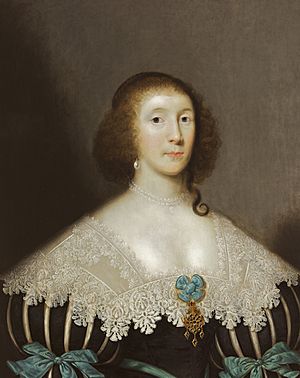Lettice Cary, Viscountess Falkland facts for kids
Quick facts for kids
Lettice Cary, Viscountess Falkland
|
|
|---|---|

A portrait by Cornelius Johnson
|
|
| Born |
Lettice Morison (or Moryson)
c. 1612 |
| Died | 1647 Great Tew
|
| Occupation | Noblewoman |
| Spouse(s) | Lucius Cary, 2nd Viscount Falkland |
| Parent(s) | Sir Richard Moryson |
Lettice Cary, Viscountess Falkland, also known as Letitia Cary, was an English noblewoman. She was born around 1612 and passed away in 1647. She married Sir Lucius Cary, who later became the 2nd Viscount Falkland.
Lettice and Lucius had four sons. They were known for hosting a famous discussion group called the Great Tew Circle. Her husband died during the First English Civil War. After his death, Lettice became very religious. She supported the King (Royalist) and the Church of England (Anglican). She passed away when she was about 35 years old.
Her Life Story
Lettice Morison (or Moryson) was born around 1612. Her parents were Mary and Sir Richard Moryson. Her father was a high-ranking official in charge of military supplies. She grew up in Tooley Park in Leicestershire.
In 1630, Lettice married Sir Lucius Cary. He was a friend of her brother, Henry. Lucius's father, the 1st Viscount Falkland, did not approve of the marriage. This was because Lettice did not come from a wealthy family. So, the couple moved to the Dutch Republic, to a city called The Hague. Lucius looked for military work there.
Between 1632 and 1639, Lettice gave birth to four sons. In 1633, her husband's father died. Lucius then became the 2nd Viscount Falkland, and Lettice became Viscountess Falkland. They moved back to England and lived at Burford Priory and Great Tew manor. Both of these homes are in Oxfordshire.
The Great Tew Circle

In the 1630s, Lettice and Lucius hosted the Great Tew Circle. This was a group of thinkers and scholars who met at their home. They discussed ideas based on the teachings of Jacobus Arminius. Famous people who joined the group included the philosopher William Chillingworth and the historian Edward Hyde. Hyde later became a very important government official called the 1st Earl of Clarendon and Lord Chancellor.
Edward Hyde described Lettice Cary as "a lady of most extraordinary wit and judgement." He also said she had "the most signal virtue and exemplary life that the age produced." This means he thought she was very smart, wise, and lived a truly excellent life.
Later Years and Devotion
In 1642, Lucius Cary became a government official called the Secretary of State. Sadly, he died the next year at the First Battle of Newbury. This battle was part of the First English Civil War.
In 1645, Lettice's oldest son, also named Lucius, passed away. Her son Henry then took on the title of viscount.
Losing her husband and eldest son made Lettice even more religious. She lived a very devout life, guided by her chaplain, John Duncon. She gave money to help poor people and built a school in Great Tew. She remained loyal to the King (a Royalist) and the Church of England (an Anglican). However, she also had friends who were Presbyterian and Roman Catholic.
Lettice Cary died at home from tuberculosis on February 24, 1647. She was buried in the church at Great Tew.
Her Lasting Impact
A famous artist named Cornelius Johnson painted a portrait of Lettice Cary.
John Duncon, her chaplain, wrote a book about her life. It was called The Returns of Spirituall Comfort. This book was printed three times between 1648 and 1653, and again in 1908. Lettice Cary was the only woman featured in a book called Memorials of Worthy Persons by Clement Barksdale in 1661. This shows how respected and admired she was.

